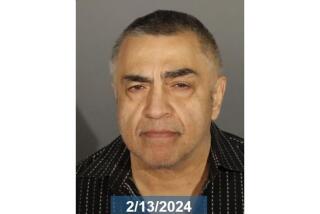Rockefeller impostor’s many aliases raised suspicions, jurors say
- Share via
Jurors who returned a murder conviction against a man who impersonated a Rockefeller family member Wednesday said his changing identities over the year made them suspicious.
Christian Karl Gerhartsreiter lived in a guesthouse on a San Marino property where John Sohus, 27, and his wife, Linda, lived. He was accused of bludgeoning Sohus with a blunt object, burying his body in the backyard and then fleeing to the East Coast, where he lived under a series of false identities, including Clark Rockefeller, a scion of America’s famous wealthy family.
“Why did he run away for a long time? Why did he change his identity if he wasn’t guilty?” Gema Vasquez, a juror, said after the verdict was announced.
The jury spent about a day deliberating before finding Gerhartsreiter guilty of first-degree murder. Gerhartsreiter, 52, faces 27 years to life in prison when he is sentenced in June.
FULL COVERAGE: Rockefeller imposter on trial
John and Linda Sohus vanished in early 1985. Linda Sohus has never been found. Gerhartsreiter, who in San Marino introduced himself as British aristocrat Christopher Chichester, disappeared soon afterward, resurfacing on the East Coast under a series of ever more elaborate false identities.
John Sohus’ body was found in 1994, buried behind the guesthouse where Gerhartsreiter once lived in an area out of sight from the main home on the Lorain Road property and from next-door neighbors.
“The body was behind his house,” said Vasquez, a nurse. “How can you not know that someone’s digging behind your house?”
More than 40 witnesses testified during the three-week trial in downtown Los Angeles, recounting stories about the charismatic Gerhartsreiter and the missing couple, who had been married less than a year and a half when they disappeared.
The key prosecution evidence was two plastic bags found wrapped around the victim’s skull. Both were in use during the early 1980s. One was from the bookstore at USC, where Gerhartsreiter attended film classes at the time. The other was from the bookstore at the University of Wisconsin at Milwaukee, where Gerhartsreiter was enrolled from spring 1980 to spring 1981.
For at least three jurors, the bags played a major role in their decisions, they said.
The proseuction had to overcome an array of obstacles. There was no DNA, fingerprints or other forensic evidence identifying the killer. Most of the victim’s remains were mistakenly destroyed in 1995. Witnesses had trouble remembering dates that were nearly 30 years old. The new lead sheriff’s detective had to deal with incomplete reports and missing evidence from previous investigators.
Deputy Dist. Atty. Habib Balian did not suggest a motive for the killing.
Juror Vincent Garcia said the lack of forensic evidence was not a big factor in the jury’s decision. Testimony about bloodstains found on the concrete floor of the guesthouse was helped convince him of Gerhartsreiter’s guilt, he said.
“You don’t really need a motive if the evidence is there,” he said. “All the evidence, if you sat through it, if you heard it, it made sense.”
The biggest debate between jurors, Garcia said, was whether to convict Gerhartsreiter on first- or second- degree murder.
Although Gerhartsreiter had lied about his identity before, he went to more extraordinary lengths to hide who he really was after the killing, particularly when a detective began seeking him in connection with the missing couple, Balian argued. Witnesses testified that Gerhartsreiter changed his address, dyed his hair, used post office boxes and kept records out of his name for the next 20 years.
Juror Salvador Ruiz, a retired truck driver from Norwalk, said he wouldn’t have been surprised if Gerhartsreiter had changed his name in coming to California because, in Hollywood, everyone changes their names. But Ruiz voted for conviction because Gerhartsreiter acted suspiciously after leaving the state, changing his identity multiple times.
Defense attorneys throughout the trial said there was as much evidence, if not more, implicating the victim’s wife in the killing. The missing Linda Sohus, they said, was far from the contented wife the prosecution portrayed and disliked living with her husband’s mother, who was controlling and drank too much.
Asked whether the jury considered Linda as the potential killer, Ruiz said, “Absolutely not.” The jury, he said, discussed the possibility for a short time but decided she could not have remained hidden for 28 years.
Vasquez said she also did not believe Linda Sohus murdered her husband and called that argument “crazy.”
“They need to let her rest,” Vasquez said. “We don’t know where she’s at…I think they need to let her rest in peace.”
ALSO:
Just looking at your phone while driving is now a crime
Loophole may cause release of 86-year-old murder suspect
Puppy tied to train tracks is up for adoption, now named ‘Banjo’
ALSO:
Twitter: @haileybranson
More to Read
Sign up for Essential California
The most important California stories and recommendations in your inbox every morning.
You may occasionally receive promotional content from the Los Angeles Times.















